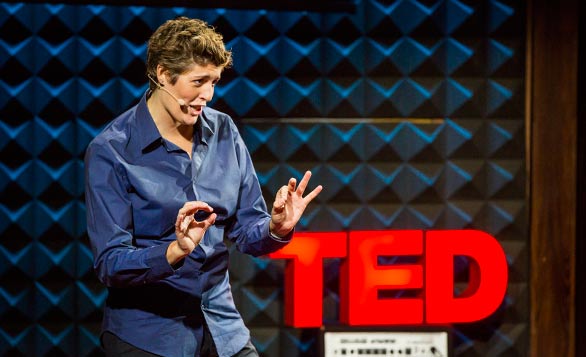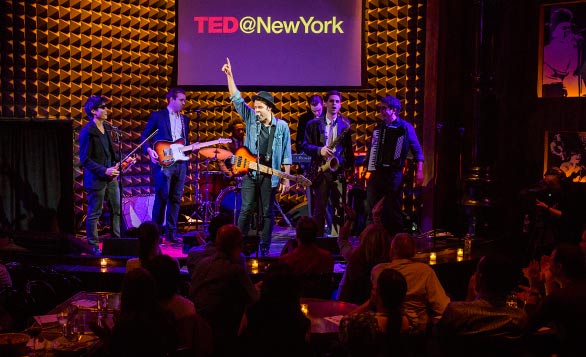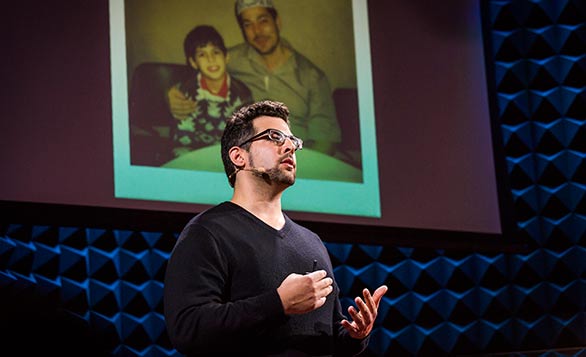
Sally Kohn, otherwise known as Fox News’ liberal and lesbian pundit, shares an idea for how to progress across political divides. Photo: Ryan Lash
A ballet dancer turned soldier. A liberal lesbian pundit on Fox News. A quantum-physicist crossword puzzler. These were among the perspectives we heard at TED@NYC, a talent search event for TED2014 held last night in New York. Below, learn a little about the 28 speakers who took the stage. You’ll see some of these speakers on TED.com in the upcoming months, while others will be invited to TED’s mainstage in Vancouver next spring to give longer versions of their talks.
Here, the speakers in order:
The evening begins with a talk from Terry Plank, who studies volcanoes for the simple reason that we still don’t understand why some are more explosive than others. Could the key to lessening damage be to crack the top and open it slowly, like you’d do with a bottle of seltzer?
In a fiercely personal talk, Sally Kohn shares what she’s learned from her three years working as a liberal lesbian pundit on conservative Fox News. She offers a powerful framework for looking past political differences: Judge people not on their political correctness, but their emotional correctness. It’s not what you say, it’s how you say it, and how you mean it — and that’s how we’re going to start have real conversations again.
Seth Porges is a treasure hunter on a mission to uncover lost history. He talks about his latest adventure – poking around the depths of New York’s Long Island Sound to find thousands of sunken pinball machines — that are among history’s only testament to New York City’s 30-year prohibition of the demon pinball.
When he returned to the United States after serving in Fallujah, ballet dancer Roman Baca found himself anxious and angry, having a hard time adjusting to everyday life. He founded a dance company, Exit 12, to reconnect and work through his emotions. The best part: returning to Fallujah to lead a group of people there in communicating their experiences and hopes through movement.
“The freaky, marginal nooks and crannies of the world are where you find mind-expanding creative opportunities,” says Simon Doonan. This taboo-busting window designer shares how he became the Creative Ambassador at Large for Barneys — and offers tips for other creative people looking for inspiring work environments.
From an early age, artist Shantell Martin loved the freedom that came with not trying to fit in. Following this passion led her to art school in London, to the clubs of Tokyo and, finally, to creating larger-than-life continuous line drawings in New York. “It’s like the pen knows where it’s going,” she says, “and I just got very good at following.”
Sociomedical scientist Mindy Thompson Fullilove fondly remembers her aunt parked in the window of her Harlem apartment building, informing her parents when she was up to no good. But as a doctor working in public health in the late 1980s, Fullilove saw crack destroy too many communities in and near Harlem. She calls on New Yorkers to find the links between rich and poor neighborhoods, and use “urban alchemy” — nature walks, art projects, and papier-mâché giraffes — to restore neighborhood connections.
A pop-up forest in Times Square? Why not! In fact, botanist Marielle Anzelone thinks there should be a forest on every corner of New York City. Worried about the loss of New York’s native biodiversity, she calls for all city dwellers to rethink how we interact with urban biomes. As the world continues to urbanize, we need to make sure that our urban meadows, forests and marshes will be there for us all.
Tomas Chamorro-Premuzic studies overconfidence – the discrepancy between how good we are and how good we think we are. He’s linked glass-half-full thinking to issues like traffic accidents and financial crises, but also to positive outcomes like new businesses. He urges us to harness the positive power of negative thinking.
Fereshteh Forough is a “proud Afghan girl.” While she acknowledges that these words are likely to conjure up images of bombs, Forough says that such was far from her experience when she returned to her family’s country in 2001 after the fall of the Taliban. Forough, now a computer science professor, believes that education for women in her country is vital, and that digital literacy must be a part of it.
With clear logic, Chad Orzel pieces together the mysteries of quantum physics as if they were a crossword puzzle — clue by clue, line by line. Surveying the key breakthroughs in quantum physics from the past century, he explains how we know that waves act like particles, and encourages the audience, even the non-scientific folk, to approach science with the same confidence and patience with which they approach crosswords.
Landscape designer Diana Balmori’s floating landscapes work to tell a new and different urban story, one in which clean air and water, storm-surge protection and pleasant city parks are merely activations of the nature that’s been lying dormant.
Climate change is real, and we will need to take drastic measures to address it. The threat has many scientists contemplating geoengineering — changing the earth in order to cool it down. But, asks bioethicist Matthew Liao, could we also try human engineering? In a modern twist on the Modest Proposal, he shares some jaw-dropping examples of what he means. If 18% of greenhouse emissions are related to raising livestock, could we create a “nicotine patch” for meat, to cause humans to stop craving it?
Singer-songwriter Tiara Thomas closes out Session 1 with acoustic versions of “Tell Me Something,” and “Popular,” both off her debut EP, Dear Sallie Mae.

CDZA takes the audience on a time machine trip through musical history. Photo: Ryan Lash
Half an hour later, Session 2 begins with a lively performance by CDZA. Opening with the confession, “We love instruments,” the music collective rocks through the history of riffage one instrument at a time – hitting some Schubert on the piano, a little Charlie Parker on the saxophone, and Hava Nagila on the accordion. At the end, an irresistible command: “Get up and dance!”
UX designer Jacob Greenshpan was confused when his daughter asked to visit the iPel tower – the Eiffel tower, of course, processed through a young mind highly familiar with the iPod, iPhone and iPad. Greenspan talks about our attraction to devices and applications, and how it tends to follow the same pattern as romantic love.
Even though Internet is as essential to survival in 21st-century America as water or electricity, a third of Americans do not have access to the World Wide Web. Drawing parallels between the modern digital divide and West Texas’s lack of electricity in the 1930s, Susan Crawford calls for government oversight and a system of publicly available Internet for all Americans.
Before she was New Jersey Attorney General, Anne Milgram assumed that our criminal justice system’s decisions were based on the risk being posed to society. But when she held the position, she was forced to realize they weren’t really based on much at all. Without a good analytics system, jails are filled with nonviolent offenders who simply can’t make bail while violent criminals walk. She thinks that moneyballing – an application of the kind of hard data used by baseball scouts – can make our streets safer and our justice system both cheaper and fairer.
Geoffrey See was surprised by something he found on his first trip to North Korea—that so many people there had been bitten by the entrepreneurial spirit and are looking to markets for options. In this talk, See describes his experience with the Choson Exchange, which holds entrepreneurial workshops in this very tough environment.
“Leave the confines of the university and go into the hood.” In an ebullient and inspiring talk, educator Christopher Emdin shares his ideas for how to teach teachers the magical engagement that can make classrooms come alive. Where can you find this magic? In barbershops, Black churches and rap concerts, he says.
With quiet, mesmerizing sincerity, Zak Ebrahim shares the story of being raised by an extremist father who would eventually be convicted in the 1993 World Trade Center bombing – and how he used his personal encounters with other faiths and cultures to overwrite that narrative of hatred and bigotry. “Violence is not inherent in any religion or race,” he says. “The son does not have to follow the father.” He dedicates his testimony to all victims of terrorism.
Macular degeneration is a condition where the retina breaks down, and people with this vision impairment have few resources available to them. But computer scientist Amnon Shashua has come up with a device to help: It’s a camera that fits onto a pair of eyeglasses and provides information through a bone conduction earpiece. In videos, and a demo, Shashua shows how this device can read street signs, detect street light color and even read the newspaper with just a point of a finger.
Parents are more hesitant to talk to their kids about weight than they are about sex, drugs and alcohol combined, says diet doctor Scott Kahan. In this reasoned talk, he offers four big-picture insights that will help parents and kids get out of adolescence with the healthiest weight possible.
Being a truck driver once meant autonomy and the romance of the open road, but recent Department of Transportation efforts to replace truckers’ paper log books with electronic monitors are putting the brakes on this vision. Not only do the machines record when a truck is in motion, but they can also record how fast a truck is going or whether it has signaled – and most truckers aren’t happy. Karen Levy takes a deep look at this essential, but often invisible, profession.
Runner Dawn J. Fraser was known as the “Turbo Toothpick” and dreamed of Olympic Gold – until an injury ended her career. In this talk, she shares the experience of watching her twin brother, Duane – also a runner, who has Down syndrome – compete in the Special Olympics and how he taught her that the real point of competition isn’t to finish first, but to make sure everyone crosses the finish line.
In this mouth-watering talk, Lior Lev Sercarz offers tips for how to spice up your life — literally. This spice adviser suggests bringing all five senses into the mix when blending spices. Taste your spices. Look at your spices. Touch your spices. Listen to your spices. Feel your spices. Let’s bring fun back to food, he says!
Conductor Jeri Lynne Johnson is bringing sexy back to classical music. Refusing to join the pity party over dwindling audiences, she recognized that it wasn’t the music she loved that needed a change, but the orchestras – so she created the Black Pearl Orchestra, a paragon of diversity and community engagement.
Singer/songwriter Elle Varner closes out the night with a musical reflection on her time as an undergrad at NYU in her song “So Fly,” and then turns to “Refill,” about a night out on the town.

Zak Ebrahim brought the audience to tears, sharing how he escaped the thinking that embroiled his father, a well-known terrorist. Photo: Ryan Lash
This piece was co-written by Liz Jacobs, Morton Bast and Kate Torgovnick.
Comments (5)
Pingback: Sally Kohn’s talk, the “clean” version | BizBox B2B Social Site
Pingback: Sally Kohn’s talk, the “clean” version | Best Science News
Pingback: Sally Kohn’s talk, the “clean” version - nuhrdspace.com
Pingback: The Girls - THE DAILY MOCHA
Pingback: Talking at TED@NYC - Sally Kohn — columnist. activist. pundit. etc.